全英文教案(格式)
完整版)全英文英语教案模板
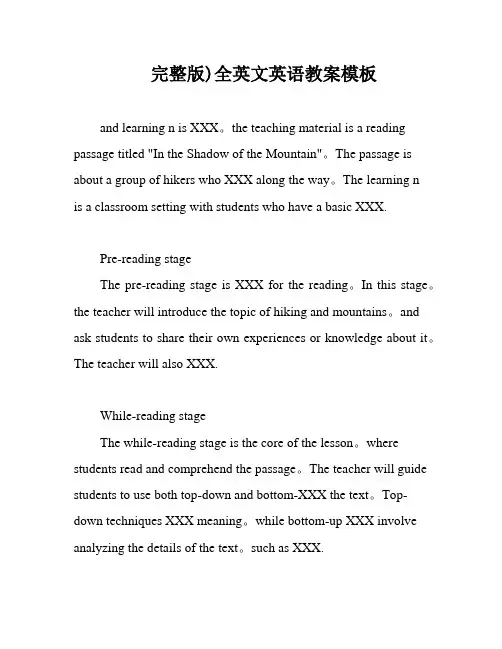
完整版)全英文英语教案模板and learning n is XXX。
the teaching material is a reading passage titled "In the Shadow of the Mountain"。
The passage is about a group of hikers who XXX along the way。
The learning nis a classroom setting with students who have a basic XXX.Pre-reading stageThe pre-reading stage is XXX for the reading。
In this stage。
the teacher will introduce the topic of hiking and mountains。
and ask students to share their own experiences or knowledge about it。
The teacher will also XXX.While-reading stageThe while-reading stage is the core of the lesson。
where students read and comprehend the passage。
The teacher will guide students to use both top-down and bottom-XXX the text。
Top-down techniques XXX meaning。
while bottom-up XXX involve analyzing the details of the text。
such as XXX.Post-reading stageThe post-reading stage is XXX' XXX of the text。
教案模板全英文
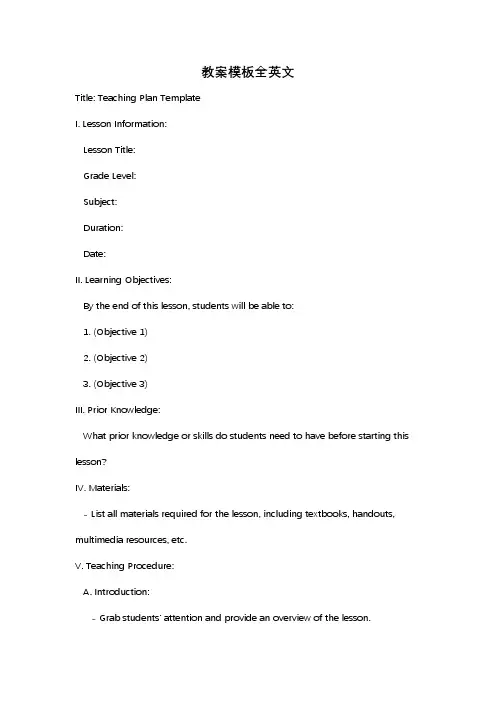
教案模板全英文Title: Teaching Plan TemplateI. Lesson Information:Lesson Title:Grade Level:Subject:Duration:Date:II. Learning Objectives:By the end of this lesson, students will be able to:1. (Objective 1)2. (Objective 2)3. (Objective 3)III. Prior Knowledge:What prior knowledge or skills do students need to have before starting this lesson?IV. Materials:- List all materials required for the lesson, including textbooks, handouts, multimedia resources, etc.V. Teaching Procedure:A. Introduction:- Grab students' attention and provide an overview of the lesson.- Connect the lesson to prior knowledge or real-life examples.B. Instructional Input:- Present new information or concepts using various teaching methods (lecture, demonstration, multimedia, etc.).- Break down complex ideas into smaller, more manageable parts.- Use visuals, examples, and analogies to enhance understanding.C. Guided Practice:- Engage students in activities or exercises that reinforce the newly learned concepts.- Provide clear instructions and model the desired behavior or thinking process.- Monitor students' progress and provide timely feedback.D. Independent Practice:- Assign individual or group activities to allow students to apply their learning independently.- Provide necessary resources and clarify expectations.- Encourage critical thinking and problem-solving skills.E. Closure:- Summarize the key points of the lesson.- Allow students to ask questions or clarify any confusion.- Provide a preview of the next lesson or connect the current lesson to future learning.VI. Assessment:- Explain how student learning will be assessed (formative and/or summative assessments).- Describe the assessment methods and criteria used.- Indicate when and how feedback will be provided to students.VII. Differentiation:- Describe any modifications or accommodations for students with diverse learning needs.- Include strategies to support English language learners, gifted students, or students with special needs.VIII. Extension Activities:- Optional activities or resources for students who finish early or want to explore the topic further.IX. Reflection:- Reflect on the effectiveness of the lesson and make notes for future improvements.- Consider student engagement, understanding, and overall lesson objectives. Please note that this teaching plan template can be adapted and customized based on the specific requirements and educational stage.。
(完整版)全英文英语教案模板
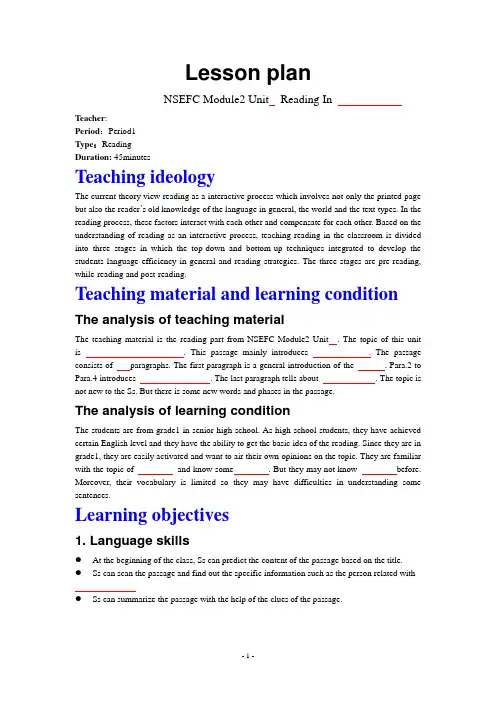
Lesson planNSEFC Module2 Unit Reading InTeacher:Period:Period1Type:ReadingDuration: 45minutesTeaching ideologyThe current theory view reading as a interactive process which involves not only the printed page but also the reader’s old knowledge of the language in general, the world and the text types. In the reading process, these factors interact with each other and compensate for each other. Based on the understanding of reading as an interactive process, teaching reading in the classroom is divided into three stages in which the top-down and bottom-up techniques integrated to develop the students language efficiency in general and reading strategies. The three stages are pre-reading, while-reading and post-reading.Teaching material and learning condition The analysis of teaching materialThe teaching material is the reading part from NSEFC Module2 Unit. The topic of this unit is . This passage mainly introduces .The passage consists of paragraphs. The first paragraph is a general introduction of the . Para.2 to Para.4 introduces . The last paragraph tells about . The topic is not new to the Ss. But there is some new words and phases in the passage.The analysis of learning conditionThe students are from grade1 in senior high school. As high school students, they have achieved certain English level and they have the ability to get the basic idea of the reading. Since they are in grade1, they are easily activated and want to air their own opinions on the topic. They are familiar with the topic of and know some. But they may not know before. Moreover, their vocabulary is limited so they may have difficulties in understanding some sentences.Learning objectives1. Language skills●At the beginning of the class, Ss can predict the content of the passage based on the title.●Ss can scan the passage and find out the specific information such as the person related with ●Ss can summarize the passage with the help of the clues of the passage.2. Language knowledge●Ss can master the key words and phrases of the passage as follows, .●Ss can learn , especially3. Affects●Ss will realize that and they will concern themselves with the issue of4. Cultural awareness●Ss will broaden their minds by knowing something about5. Learning strategies●Ss will cultivate their ability individual learning and cooperative learning by doing someactivities independently and some in groups.●Ss will communicate with each other in English while doing the group work. Language focuses and anticipated difficultiesLanguage focusesThis is a reading period so the focus is to cultivate the students’ reading skills. The many activities are designed to help Ss to train their reading skills, such as predicting, skimming, scanning and summarizing.It is also important for the Ss to master the new words and phrases.Anticipated difficultiesAs the Ss have a limited vocabulary, so they may have some difficulties in understanding the passage. So the teacher will help them learn the new words and phrases.Ss may did not heard before, so the teacher will tell them some background knowledge about it.Teaching methodThree-stage model: Based on the understanding of reading as an interactive process, teaching reading in the classroom is divided into three stages in which the top-down and bottom-up techniques integrated to develop the students language efficiency in general and reading strategies. The three stages are pre-reading, while-reading and post-reading.Teaching aidsMultimedia devices and PPT documents: In order to help Ss to fully understand the whole passage, I adopt Multimedia devices and PPT documents to bring the real-life situation into the classroom.Teaching proceduresStep1. Lead-in (6min)Activity1. Greetings and Free-talking (2min)T Leads into the topic by asking Ss some they know. Ss tell the name of the they know freely.T: Hello boys and girls.(Ss say hello to the teacher.)T: When we say , what appears in your minds?(Ss tell the things appear in their minds freely.)T: What are the ?(Ss tell some names of .)Activity2. Picture-talking (4min)T shows some pictures about the in China and abroad. After seeing the pictures, Ss are expected to tell the similarities of them.T: Just now, you talk about some in China. Now, let’s see some pictures of some . (T shows the pictures and Ss see them carefully.)T: What do the have in common?For example, they are very precious. What are your opinions?(T gives them some hints and Ss tell the characteristics of )[Aims]In this step, T first leads in the topic by talking with the Ss freely about the which is familiar to them and then Ss see some pictures and tell the characteristics. These two activities aim to arouse the Ss’interests in the topic and activate their old knowledge of . Then Ss will be mentally prepared for the reading comprehension. What’s more, when they are talking about the charateristics of, they will realize that the are rare and precious and they will concern themselves with the issue of .Step2. Pre-reading (3min)Activity1. Knowing something about (1min)T gives a brief introduction of the. Ss will know the.T: Today, we are going to learn . It is . Do you know what is? (T shows some pictures of and Ss get to know the .)Activity2. Predicting (2min)T asks Ss to read the title of the passage and then ask them some questions. Ss will predict the content of the passage with the help of the title.T: please look at the title “”, what does “动词” mean?(If the Ss can not give the answer, then T explain it.)T: In search means that people are looking for it. Why are people looking for it? Can you guess? What will the passage talk about?(Ss predict the content, but T will not give the answer here.)[Aims]In this step, the Ss first know some information of the ; the background information will make it easier for the Ss to understand the passage. Then T asks Ss to make predictions about the passage. It aims to help Ss develop the reading skills of predicting.Step3. While-reading (22min)Activity1. Skimming (4min)Ss skim the whole passage and find out and check their predictions.T: Why are people still ? Here is a multiple choice for you.Activity2. Scanning (3min)T presents several true or false statements and asks the Ss to scan the passage and judge the right from the wrong.(Keys: F,F,T,T,F)Activity3 Close-reading (15min)T designs various kinds of activities and Ss do the activities to fully understand the passage. Para.1T: Please read Para.1 carefully and then take some note about the .Para.2-4Please read Para.2-4 carefully and then find out the removal of the room.Please read Para.2-4 carefully and then find out the person related with the Amber Room and the things them down with it.Para.5Please read Para.5 carefully and then find out the the rebuilding of the amber room.[Aims]By doing some many activities, the Ss will develop their reading strategies and language efficiency. T help the Ss study the passage paragraph by paragraph.. Ss will learn some key words and phrases in the passage.Step4. Post-reading (12min)Activity1. Dissuasion (6min)Ss have learned the rebuilding of the passage and T asks the Ss to discuss whether people . T give the example of “” which is . Ss share their opinion on the issue and the reasons.Activity2. Role-play (6 min)T creates a situation in which a student of the class has visited the Amber Room, so he/she come back to introduce the amber room.Ss work in pairs, one act as the one who has visited the palace. The other acts as one who is curious about the Amber Room, they should make a dialogue.The beginning of the conversation is given.A: the one who has visited the palaceB: the one who is curious about the Amber Room[Aims]These two activities are to develop the Ss’comprehensive language competence. The role play serves to be an output of the reading and an evaluation of their learning.Homework (1min)Ss write a summery ofSs review the words and phrase of the passage and make sentence with each. Blackboard designInterpretationGood morning, ladies and gentlemen. It’s my great honor and pleasure to be here sharing my lesson with you.I have been ready to begin this representation with five parts. Analysis of the teaching material, the teaching aims, the important and difficult points, the studying methods, and the teaching procedure.Part 1 Teaching MaterialThe content of my lesson is New Senior English for China Book___ Unit____________________. This unit is about____________________ (topics). By studying of this unit, we’ll enable students to know_________________________ and develop the interest in___________________. At the same time, let the students learn how to____________________ (functional items). From this lesson, it starts___________________________(structures). (As we all know, reading belongs to the input during the process of the language learning. The input has great effect on output, such as speaking and writing.) Therefore, this lesson is in the important position of this unit. If the Ss can master it well, it will be helpful for them to learn the rest of this unit.Part 2 Teaching AimsAccording to the new standard curriculum and the syllabus (新课程标准和教学大纲), and after studying the teaching material, the teaching aims are the followings:1.Knowledge objects (语言目标:语音,词汇,语法,功能,话题)(1)The Ss can master the usage of the important words and expressions.(2)The Ss can use the __________________ (grammar) in the proper situation.(3)The Ss can understand the content of the lesson, talk about _______________________ (information) and get their own idea about_______________________________.2.Ability objects (技能目标:听,说,读,写)(1) To develop the Ss’abilities of listening, speaking, reading and writing(2) To guide Ss to set up effective studying strategies.(3) To improve the student’s reading ability, especially their skimming and scanningability.(4) To train the Ss’abilities of studying by themselves and cooperating .3.Emotion or moral objects (情感目标:兴趣,自信,合作,爱国,国际视野)(1)By completing the task, the Ss increase their interest in ____________________and set up self-confidence in _____________________.(2)Teach the Ss_________________________, put the moral education in the language study. Part 3 the Important and Difficult PointsBased on the requirement of the syllabus.The important points are__________________________ such as ______________. The difficult points are_________________________ for example_____________. Part 4 Teaching Methods As is known to us all, a good teaching method requires that the teacher should help Ss develop good sense of the English language. For achieving these teaching aims,1(after the analysis of the teaching material and teaching aims,) I will use the following methods according to the modern social communication teaching theories(现代社会交际教学理论) .1. Communicative Approach(交际教学法)2. Whole Language Teaching(整体语言教学法)3. Task-based Language Teaching (任务教学法)4. Total Situational Action (情景教学) a “scene —activity”teaching method , it establishes a real scene and the interaction between the teacher and the Ss. At the same time, CAI (电脑辅助教学) can provide a real situation with its sound and picture, it can develop the Ss creativity in learning English.Part 5 Teaching ProcedureStep 1. Lead-in. (_____min)___________________________________________________________________ Purpose of my design: (1) to catch Ss’attention about the class/topic/passage.(2) To set up suspense/develop interest in _______________.Step 2. Pre-readingTask 1. (Individual work, pair work, group work, class work; _____min)Let Ss _____________________________________________________________ Task 2. (Individual work, pair work, group work, class work; _____min)___________________________________________________________________ Now, let’s see what happened to the_______________/ let’s check whether it is right or not.Purpose of my design: (1) to get to know something about the _________________.(2) To have a better understanding about the importance of ___________________. Step 3. While-readingTask 1. (Individual work, pair work, group work, class work; _____min)Skimming: Ss should read the material fast to find out the main idea/topic sentence for each paragraph.Para 1 ___________________Para 2 ___________________Para 3 ___________________…Task 2. (Individual work, pair work, group work, class work; _____min)Scanning: Listen to the tape part by part to finish ___________________________.Task 3. (Individual work, pair work, group work, class work; _____min)Scanning: Guide Ss to read the material carefully and take some important notes, then answer the following questions.Task 4. (Individual work, pair work, group work, class work; _____min)Scanning: Ask Ss to read the material carefully and find out the correct answers to finish the following chart.第2/3页Purpose of my design: Enable students to understand the given material better by using different reading skills. And proper competition can arouse the Ss’interest in English learning. “Task-based”teaching method is used here to develop the Ss’ability of communication and also their ability of co-operation will be well trained. Step 4. Post-readingTask 1. (Individual work, pair work, group work, class work; _____min)(接task3)Ask Ss to close books and finish the summary according their notes. (接task4)Retell the story /Sum up the passage in Ss’own words according to the chart.Task 2. (Individual work, pair work, group work, class work; _____min)Discuss _______________________________________________with other group members and then choose a reporter to share their opinions about ____________________________________ with the whole class.Purpose of my design: I think If the Ss can finish this task well, they will benefit a lot in their spoken English. Most Ss can take their parts in the activities, especially for the Ss who have trouble in English study.Step 5. Homework1. __________________________________________________2. __________________________________________________Purpose of my design: Homework is so important and necessary for to master the knowledge they learned after class. It will check whether the Ss achieve the teaching aims.。
(英语教案)三年级英语教案全英文
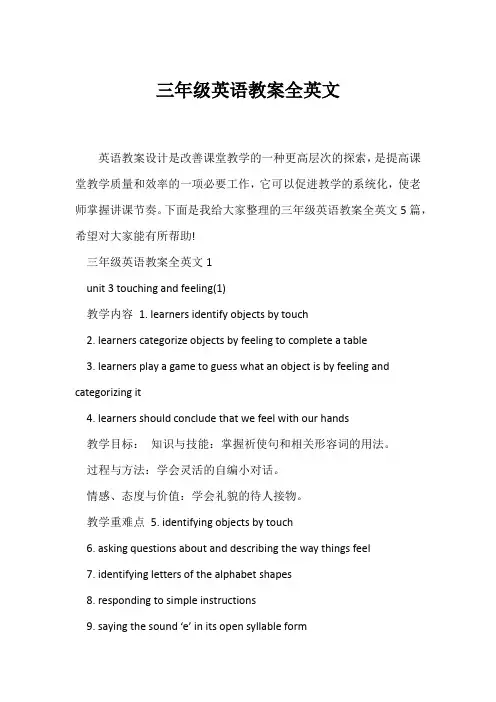
三年级英语教案全英文英语教案设计是改善课堂教学的一种更高层次的探索,是提高课堂教学质量和效率的一项必要工作,它可以促进教学的系统化,使老师掌握讲课节奏。
下面是我给大家整理的三年级英语教案全英文5篇,希望对大家能有所帮助!三年级英语教案全英文1unit 3 touching and feeling(1)教学内容1. learners identify objects by touch2. learners categorize objects by feeling to complete a table3. learners play a game to guess what an object is by feeling and categorizing it4. learners should conclude that we feel with our hands教学目标:知识与技能:掌握祈使句和相关形容词的用法。
过程与方法:学会灵活的自编小对话。
情感、态度与价值:学会礼貌的待人接物。
教学重难点5. identifying objects by touch6. asking questions about and describing the way things feel7. identifying letters of the alphabet shapes8. responding to simple instructions9. saying the sound ‘e’ in its open syllable form教学准备cassette 3b and a cassette player, wall pictures, cushion, pineapple, apple教学过程教师活动学生活动教学意图pre-task preparation . revision1.put on the masks then play the game.2.what can you do introduce.3.show the pictures. what’s this/thatis this/that… what do you see1.words: soft, hard, rough, smooth1.t: what do you see p:i see some sweets.2..touch the sweets one by one then teach〞soft〞3.what is soft please tell me.4.touch the desk then teach “hard〞.5.the same way to teach “rough, smooth〞6.make a new rhyme.2 play the cassette again. students repeat.3 invite individual students to come to the desk. give them a thing to touch and feel. students have to close their eyes when they play the game.say: touch it. how does it feelto elicit: its ...ask: what is itto elicit: its at an ...ask the questions.用旧知引入新知识,新单词。
英语教案范文全英文版
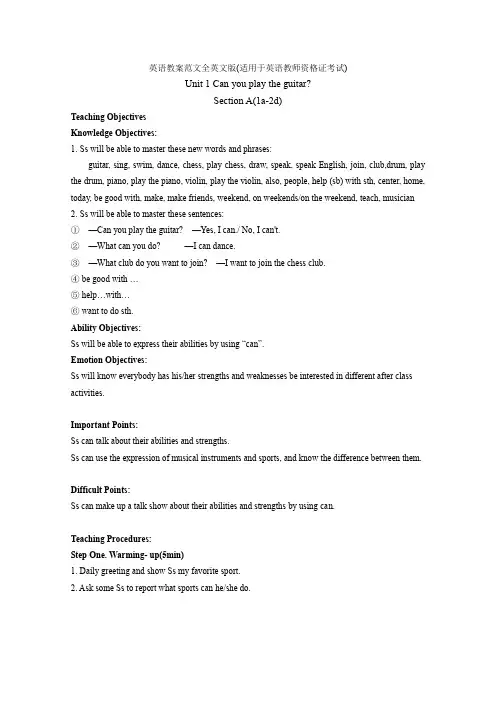
英语教案范文全英文版(适用于英语教师资格证考试)Unit 1 Can you play the guitar?Section A(1a-2d)Teaching ObjectivesKnowledge Objectives:1.Ss will be able to master these new words and phrases:guitar, sing, swim, dance, chess, play chess, draw, speak, speak English, join, club,drum, play the drum, piano, play the piano, violin, play the violin, also, people, help (sb) with sth, center, home, today, be good with, make, make friends, weekend, on weekends/on the weekend, teach, musician2.Ss will be able to master these sentences:①—Can you play the guitar? —Yes, I can./ No, I can't.②—What can you do? —I can dance.③—What club do you want to join? —I want to join the chess club.④be good with …⑤help…with…⑥ want to do sth.Ability Objectives:Ss will be able to express their abilities by using “can”.Emotion Objectives:Ss will know everybody has his/her strengths and weaknesses be interested in different after class activities.Important Points:Ss can talk about their abilities and strengths.Ss can use the expression of musical instruments and sports, and know the difference between them.Difficult Points:Ss can make up a talk show about their abilities and strengths by using can.Teaching Procedures:Step One. Warming- up(5min)1. Daily greeting and show Ss my favorite sport.2. Ask some Ss to report what sports can he/she do.Step Two. Pre-listening(5min)Brainstorming: musical instruments and sports.Presentation: new wordsSs are going to finish Activity 1a.Step Three.listening(20min)1.Ss are going to finish Listening Activity 2b.2.Two groups of Ss are going to show some activities they can do and what they like doing, using I can... I like after school.3.Ask Ss what clubs they want to join and their reasons, using I want to join... because...4.Ss are going to listen the conversation 2d and answer these questions:①What clubs do Bob and Jane want to join? Why?②What can Bob and Jane do?5.Ss are going to learn some sentences in the conversation.6.Role playStep Four. Speaking(10min)Ss are going to do a survey and give a report about what they and their partners can do and what clubs they want to join.Step Five. Summary(5min)Ss are going to summarize what they have learned today.Homework1.Sum up and copy the new stuff.2.Read the dialogue and try to recite it.。
大学英语教案模板全英文版(10篇)
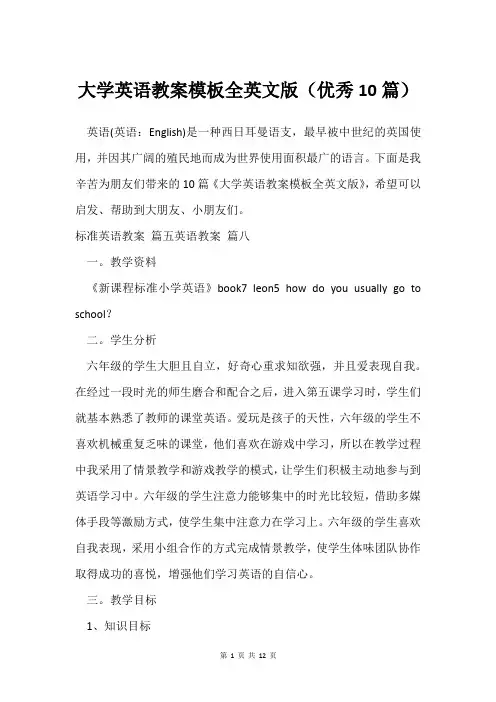
大学英语教案模板全英文版(优秀10篇)英语(英语:English)是一种西日耳曼语支,最早被中世纪的英国使用,并因其广阔的殖民地而成为世界使用面积最广的语言。
下面是我辛苦为朋友们带来的10篇《大学英语教案模板全英文版》,希望可以启发、帮助到大朋友、小朋友们。
标准英语教案篇五英语教案篇八一。
教学资料《新课程标准小学英语》book7 leon5 how do you usually go to school?二。
学生分析六年级的学生大胆且自立,好奇心重求知欲强,并且爱表现自我。
在经过一段时光的师生磨合和配合之后,进入第五课学习时,学生们就基本熟悉了教师的课堂英语。
爱玩是孩子的天性,六年级的学生不喜欢机械重复乏味的课堂,他们喜欢在游戏中学习,所以在教学过程中我采用了情景教学和游戏教学的模式,让学生们积极主动地参与到英语学习中。
六年级的学生注意力能够集中的时光比较短,借助多媒体手段等激励方式,使学生集中注意力在学习上。
六年级的学生喜欢自我表现,采用小组合作的方式完成情景教学,使学生体味团队协作取得成功的喜悦,增强他们学习英语的自信心。
三。
教学目标1、知识目标a.使学生能熟记bus,car,train,on foot新词汇b.使学生能熟记用句子how do you usually go to school?i usually go to school by…?进行对话2、本事目标使学生能把学到的知识运用到实际生活中去3、情感目标培养学生的自我表达本事和团队合作精神四。
教学重点与难点1、熟记所学新单词,做到发音准确,拼写正确2、能过把新单词运用到句型i usually go to school by……?五。
教学方法情景教学法与游戏教学法相结合六。
学习方法自主学习与小组合作相结合七。
课前准备单词卡片、短语卡片、幻灯片等八。
教学过程1、新课导入首先全班同学起立合唱leon3中的歌曲where do you e from?吸引学生注意力到课堂学习中,同时营造一个良好的英语学习氛围,为新课学习做准备。
大学英语教案模板全英文
大学英语教案模板全英文大学英语教案模板全英文篇一:大学英语教案经典模板教案Practical College English新认知大学实用英语综合教程教研室:公共课部教师姓名:freefishwang大学英语教案模板全英文篇二:大学英语教案范本全新版《大学英语》教案课程名称:大学英语(一级)专业:本校05普通本科年级:2005学年:2005-2006学期:第一学期任课教师:全新版《大学英语》板块任课教师Course ScheduleAims:1. Developing Ss’ability of independent learning to be automatic learners.2. Enhancing Ss’ability in using English: improving Ss’five micro-skills—listening,speaking, reading, writing, translation —especially listening andspeaking so that they can communicate in spoken and written English.Required course materials:1. College English (Book 1)—Integrated Curse, Listening and Speaking Course, Reading CourseNote: Reading Course book is used as Ss’self-access material. 2. One Dictionary:Teaching and Learning:1. Keep in mind that it is YOU who have to study to improve your English. If you do not studyby yourself, there is no use in coming to class. In other words, just listening to the teacher and other students in class does not help you improve your English.2. Be well prepared when you come to class. It is of great importance for you to preview thecourse materials before class according to the course schedule. If not, you’ll find it very difficult to follow the class.3. Class participation is vital. You should actively join in pair work or group discussion and dooral presentation before class.4. It is important to turn in any assignments by the due date. Ifyou know that you have acircumstance which will makes it impossible for you to turn in your assignment by the due date, you can and should come to consult with me about your problem beforehand.5. Your essays should be done in a loose-leaf notebook so as to hand in your assignments by aloose paper.6. Since attendance/absence is part of evaluation, keep in mind that your absence will reduceyour evaluation.Useful English Learning Resources:Magazines: English Language Learning, College English, English Salon, English Weekly, The world of English, English Digest, Overseas EnglishNewspaper: 21st Century, China DailyWebsites: (英语比萨园地); (听力快车); (普特英语听力); (英文写作网); (旺旺英语); .cn (中国日报);(华盛顿邮报)Unit 1 Writing For Myself1. 教学目标及基本要求:Objectives:Students will be able to:1) grasp the main idea (the essence of writing is to write what one enjoys writing) and structure of the text (narration in chronological sequence);2) appreciate the narrative skills demonstrated in the text (selection of details, repetition and the use of synonyms.)3) master the key language points and grammatical structures in the text;4) conduct a series of reading, listening, speaking and writing activities related to the theme of the unit.2. 教学内容及学时分配:Time allotment:1st period: pre-reading; text organizationnd2 period: while-reading3 period: post-reading activities4 period: reading practice5th period: speaking6 period: writing3. 教学重点及难点:Important language points in the text:4. 教学内容的深化及拓宽:ththrdStudents conduct a series of reading, listening, speaking and writing practice to deepen their understanding of the points taughtin class.5. 教学方式及在教学中应注意的问题:A combination of traditional teaching methods with the communicative approach will be adopted. Special attention should be paid to classroom interaction. Give students time to adapt to the new teaching mode in the university that are quite different from the one they were used to in the middle school. More encouragement is needed and more guidance will be given to them in their extracurricular study.6. 主要参考书目:季佩英,吴晓真,2001,《全新版大学英语综合教程1-教师用书》。
中职英语教案设计万能模板全英文
I. Introduction1. Course Title: [Name of the Course]2. Subject: English3. Grade Level: [Grade Level]4. Duration: [Total Duration of the Lesson]5. Learning Objectives:- Knowledge: Students will be able to understand and use [specific vocabulary and grammar points].- Skills: Students will be able to [list specific skills such as listening, speaking, reading, and writing].- Attitudes: Students will develop a positive attitude towards learning English and improve their confidence in using the language.II. Lesson Overview1. Topic: [Main topic of the lesson]2. Purpose: To [explain the purpose of the lesson, e.g., introduce new vocabulary, practice a specific grammar structure, or develop a particular skill].3. Materials: [List of materials needed, e.g., textbooks, handouts, multimedia resources, etc.]4. Activities: [Outline of activities planned for the lesson, e.g., group work, pair work, individual tasks, etc.]III. Warm-Up (5 minutes)1. Activity: [Brief activity to engage students and activate prior knowledge, e.g., a quick review of previous lesson content, a simple game, or a vocabulary brainstorming session].2. Purpose: To get students thinking about the topic and ready for the main lesson.IV. Main Content (25 minutes)1. Vocabulary and Grammar Focus:- Vocabulary: [List of new vocabulary words and phrases with examples of use].- Grammar: [Explanation of the specific grammar point(s) to be covered].2. Activity 1: [Activity Name]- Description: [Detailed description of the activity, including instructions and roles of students].- Purpose: [Explain how this activity helps students learn the vocabulary and grammar focus].3. Activity 2: [Activity Name]- Description: [Detailed description of the activity, including instructions and roles of students].- Purpose: [Explain how this activity reinforces the learning from Activity 1 and further develops the vocabulary and grammar skills].V. Practice (10 minutes)1. Activity 1: [Activity Name]- Description: [Detailed description of the activity, including instructions and roles of students].- Purpose: To provide students with opportunities to practice the new vocabulary and grammar in a controlled setting.2. Activity 2: [Activity Name]- Description: [Detailed description of the activity, including instructions and roles of students].- Purpose: To encourage students to use the new vocabulary and grammar in more open-ended and creative ways.VI. Review and Consolidation (5 minutes)1. Activity: [Activity Name]- Description: [Brief activity to review the main points of the lesson, e.g., a quick quiz, a class discussion, or a summary activity].- Purpose: To reinforce learning and ensure that students have understood the key concepts.VII. Homework Assignment1. Task: [Description of the homework assignment, including specific instructions and due date].2. Purpose: To provide students with additional practice outside of the classroom and to reinforce the learning from the lesson.VIII. Assessment1. Formative Assessment:- Observations: Teacher observations during activities.- Class Participation: Students' engagement and contribution during class discussions and activities.2. Summative Assessment:- Homework: Completion and quality of the homework assignment.- Tests/Quizzes: Written tests or quizzes to assess understanding of vocabulary and grammar.IX. Reflection。
幼儿园英语教案全英文模板
---Objective:To [describe the main objective of the lesson, e.g., introduce new vocabulary, practice a language skill, or develop a specific learning outcome].Grade Level:[Specify the grade level or age range of the children, e.g., Preschool (3-5 years old)].Subject:English Language ArtsDuration:[Indicate the duration of the lesson, e.g., 30 minutes, 45 minutes].Materials Needed:- [List all materials required for the lesson, e.g., flashcards, puppets, songs, storybooks, craft supplies, etc.].Preparation:- [Describe any preparation steps required before the lesson, e.g., setting up the classroom, preparing activities, or gathering materials].Warm-Up (5 minutes):1. Activity: [Describe a brief activity to engage the children and get them ready for the lesson, e.g., a simple game, a song, or a circle time discussion].2. Purpose: To build excitement and focus the children on the upcoming lesson.Main Activity (20-25 minutes):1. Activity 1: [Describe the first activity, e.g., Vocabulary Introduction]- Description: [Explain how the activity is conducted, e.g., showing flashcards with pictures and words, or using puppets to introduce new vocabulary].- Purpose: To introduce new vocabulary and familiarize the children with the target language.2. Activity 2: [Describe the second activity, e.g., Language Skill Practice]- Description: [Provide details on how the children will practice the language skill, e.g., through a role-play scenario, a group activity, or a game].- Purpose: To reinforce the language skill learned in Activity 1 and provide practical application.3. Activity 3: [Describe the third activity, e.g., Storytelling]- Description: [Describe how a storybook or a puppet show will be used to enhance language learning, e.g., reading a story aloud and pausing to ask questions or act out parts].- Purpose: To develop listening skills and comprehension, while also introducing new vocabulary and phrases.Cool Down (5-10 minutes):1. Activity: [Describe a closing activity, e.g., a review game, a song, or a dance routine].2. Purpose: To review the main points of the lesson and provide a fun and relaxing way to end the session.Assessment:- Formative Assessment: Observe the children during activities to assess their understanding and participation.- Summative Assessment: [Describe any formal assessment methods, e.g., a quiz, a worksheet, or a performance task].Follow-Up Activities:- [List any additional activities or resources that can be used to extend the learning beyond the lesson, e.g., homework assignments, online games, or parent involvement activities].---Example of a Filled-in Template:Objective:To introduce and practice colors (red, blue, yellow) and basic color mixing concepts.Grade Level:Preschool (3-5 years old)Subject:English Language ArtsDuration:45 minutesMaterials Needed:- Color flashcards- Color mixing experiment kits (e.g., red, blue, yellow food coloring, clear plastic cups, water)- White paper- Paintbrushes- Optional: Storybook about colorsPreparation:- Set up a table with the color mixing experiment kits and prepare white paper for each child.- Read the storybook about colors ahead of time to familiarize yourself with the content.Warm-Up (5 minutes):1. Activity: Color Song。
完整版)优秀全英文教案模板
完整版)优秀全英文教案模板nal DesignName: Li XinyingSubject: Listening and SpeakingLesson type: Grade 8 - XXX Park?XXX:XXX and Guiding PrinciplesThe goal of this XXX is to help students XXX activities。
students will also have the XXX objectives。
I will primarily use Task-based Teaching Method。
Natural Approach。
XXX。
students will learn in a XXX approach will help them develop the habit of active learning and XXX.First of all。
the lesson will begin with a real-life n using the Natural Approach。
A video clip of an amusement park will be shown to arouse students' sity。
Following this。
I will display pictures of the new vocabulary words。
such as amusement park。
space museum。
aquarium。
and zoo。
to help students prepare for the XXX.In the third n。
I will use the Task-based Teaching Method to set three tasks for extensive listening。
- 1、下载文档前请自行甄别文档内容的完整性,平台不提供额外的编辑、内容补充、找答案等附加服务。
- 2、"仅部分预览"的文档,不可在线预览部分如存在完整性等问题,可反馈申请退款(可完整预览的文档不适用该条件!)。
- 3、如文档侵犯您的权益,请联系客服反馈,我们会尽快为您处理(人工客服工作时间:9:00-18:30)。
职称
Professional Title
学时
Teaching
Hour
40minutes
授课题目(章、节)
Teaching Topic (chapter)
Handhugiene
教材(名称、主编、出版社、出版时间、版本)
Textbook (Title, chief editor, publishing house, publishing Date, Version)
9.小结(Summary)
10.思考题(Questions)
11.主要参考资料(References and text-books recommended)
12.系(教研室)主任审核签字盖章(Signature andstamp of the department director)
Teaching plan of Kunming Medical University
6.多媒体及板书设计要点(Designs of multi-media and blackboard writing)
7.授课内容及教学设计(Teaching contentsandorganization)
8.课堂教学效果评价方法(Evaluation methodstothe teachingeffectiveness)
昆明医科大学教案
School
Thethirdclinical college of Kunming Medical University
系(教研室)Department
Department of surgery
课程名称Course Name
年级
Grade
In grade one
授课教师
Teacher
4.学情分析(Analysis to students, including what contents the studentshavestudied, theБайду номын сангаасr learning habit, characteristic and so on.)
5.教学方法与手段(Teaching method and strategy)
撰写要点(Writing Key Points):
1.教学目标(Teaching objectives)
2.教学重点、难点及解决方案(Teaching focus, difficult points andthesolutions)
3.教材分析及教学内容重组整合(Analysis to textbook and the integration of teaching content)
